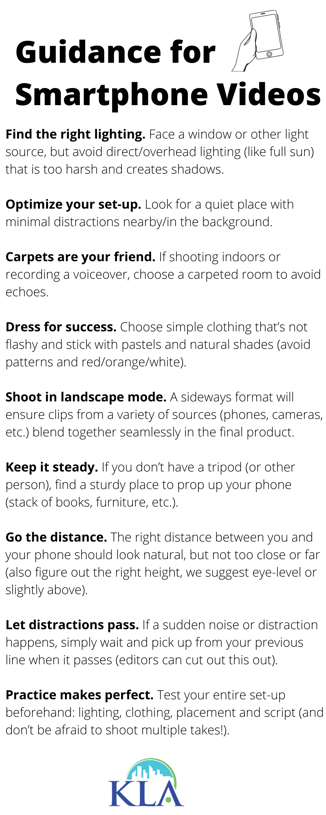Video: Why it’s important and how to do it on any budget
Cities, towns and counties of all sizes should incorporate video in their climate action, sustainability and resilience work. Why?
- About 82% of internet traffic this year is expected to be video.
- If you hear a piece of information, you remember about 10% of it a few days later. If that info is presented in video (so you see *and* hear it), you can remember 65%.
- Video is shared 12 times more than text and images – and 92% of mobile users share videos.
If you want community members to take a survey, come to a meeting, know about a program or take some action, video might just be the ticket!
Here are 4 ways KLA clients have used video:
1. Launch a Community Planning Process: Resilient Together (Beverly and Salem)
Summary: Released in the early stages of the cities' joint Resilient Together climate action and resilience planning process.
Unique Feature/Format: Even during a pandemic, the two mayors came (not too close) together on the bridge that links to their cities. We ensured a safe "set" by keeping distance, having the crew wear masks, providing hand sanitizer and using a tracking list.
Why this Approach: The video is heavy on clips from local residents representative of their cities' diversity and underscore how climate action and resilience impact everything from the local economy to waterfront redevelopment.
Other clients who have used video to kick off the start of a planning process: Weston Ahead in MA and All-In Clark County in NV.
2. Launch a Final Community Plan: Sustainable Dedham Climate Action and Resilience Plan
Summary: Video to coincide with the release of the Sustainable Dedham Climate Action and Resilience Plan
Unique Feature/Format: Video closing with short smartphone clips of Dedham residents and community leaders. Scroll down for some specific recommendations for budget-friendly smartphone videos.
Why this Approach: The client was going for an upbeat vibe and bringing in lots of faces. With budget constraints and COVID restrictions, we opted for an ending series with a montage of video snippets that community members (who are engaged with sustainability initiatives in Dedham) shot themselves on smartphones. Each person just had to read one very short part that, combined with the other segments, formed the video conclusion. That made it easy for people to memorize/recite and gave the feeling of “we’re in this together.”
Other clients who produced videos to unveil their plans: Devens Forward and Resilient Watertown in MA.
3. Raise Awareness on a Topic: Concord’s Video Series
Summary: 3-part series on Electric Vehicles, Water Efficiency, and Community Preparedness
Unique Feature: Series that touches on why each topic is important to the viewer and to the Town’s sustainability goals and how the viewer can take action.
Why this Approach: With lots of information for each distinct topic and a desire to do a bit more than skim the surface, Concord opted for a series. The videos have similar production elements that allow them to stand alone but also be presented together.
4. Promote a Program or Service: Dashboard video
Summary: We helped several KLA clients produce short (30-second) videos to promote their Climate/Sustainability Dashboards.
Unique Feature: Short videos are easier to share via social media, emails/newsletters, partners, and embedding on webpages.
Why this Approach: Can be done on a smaller budget and with minimal production (i.e. utilize existing images and footage, single voiceover).
Tips and Tricks of the Trade
We’ve learned a lot in producing these videos. Last year, we sat down with our video production partner — David Pichette of Mainstage Media — to talk about the process and best practices. Check out those tips here. Scroll down for some specific recommendations for budget-friendly smartphone videos.
Psssst…Video is Affordable
Adding videos to your toolbox doesn’t have to break the bank. How?
Gone is the need for days-long, budget-draining video shoots that are often inaccessible to smaller towns and cities. Putting out a video is easier than you think! Here are some ways we’ve helped clients keep video costs in check:
- Partner with local government or local nonprofit and public access TV stations to use previous or shoot new footage.
- Collaborate with local real estate agents or drone enthusiasts to use previous or capture new aerial footage.
- Skip the cost of a video crew for interviews and use voiceovers – and even smartphone videos -- instead (see below for tips).
- Create a “shot list” and ask other local government departments (like Economic Development and Parks and Recreation), schools and universities, Chamber of Commerce and tourism entities if they have photos and/or video footage you could use.
Ultimately, video is an investment that pays off.
Bottom line: Would you rather scroll through a webpage and READ about a new program or sit back and WATCH a video? When both text and video are available on the same page, 72% of people would rather use the video to learn about a new product or service.
If you're considering video but want to figure out what approach works for your community and budget, give us a shout.






